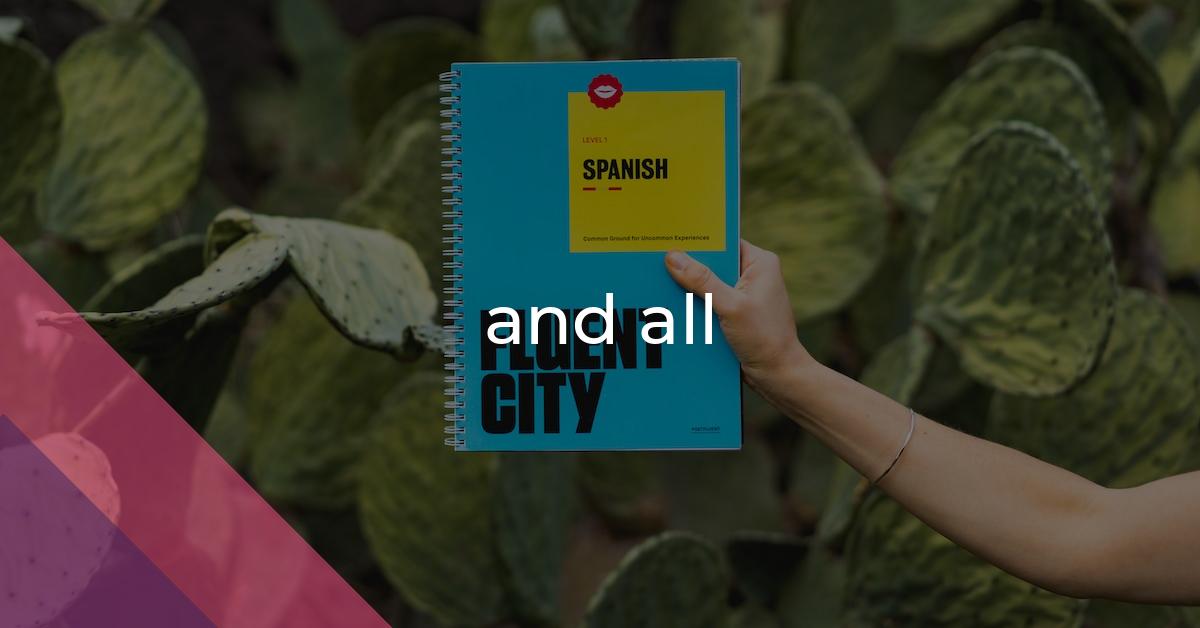and all: Idiom Meaning and Origin
What does ‘and all’ mean?
The idiom "and all" is used to emphasize or add extra information to a statement. It is often used at the end of a sentence or clause, and can be seen as a way to confirm or emphasize that a statement is true.

Idiom Explorer
The idiom "when all is said and done" means that after everything has been considered or taken into account, and all actions have been taken, the final result or outcome will become clear.
The idiom "say it all" means to fully express or reveal everything, leaving nothing unsaid or unexplained.
The idiom "one and all" means every single person or thing, without exception.
The idiom "it's all good" is used to express that everything is okay or there are no problems. It is often used to reassure others or to indicate that there is no reason to be worried or concerned.
The idiom "good and" is used as an intensifier to indicate something is very much or completely in a certain state or condition.
The idiom "go all the way" means to fully commit or complete a task or action without hesitation or reservation.
The idiom "for good and all" means to do something once and for all, or to fully complete or resolve a situation. It implies a final and decisive action, leaving no room for further discussion or uncertainty.
The idiom "for all the world" means in the strongest or most obvious way. It is used to emphasize the certainty or truth of a statement or situation.
"Every last" is an idiom used to emphasize that every single person or thing in a group is included or accounted for. It highlights the completeness or thoroughness of an action or process.
The idiom "end of" is used to emphasize that something is final or absolute, with no possibility of further discussion or negotiation. It is often used to express a strong opinion or to indicate a decision that is not open to debate.
All and more
6. Another related idiom is "one and all," which is often used to express inclusivity or universality. It implies that something applies to every single person or entity without exception. For example, "This rule applies to students one and all" emphasizes that the rule is relevant to every student, leaving no one out.
7. "and finally" is another idiom that is similar to "and all." It is used to introduce the last point or topic in a series or to emphasize the conclusion of a discussion. For instance, "We have discussed the benefits of exercise, a healthy diet, and stress management, and finally, the importance of getting enough sleep."
8. One more idiom related to "and all" is "be-all and end-all." This phrase is used to describe something that is considered the ultimate or most important thing. It implies that nothing else matters as much as the thing being referred to. An example would be, "For him, success in his career was the be-all and end-all of his life."
The idiom "and all" is often used in conjunction with other idiomatic expressions to add depth and nuance to the language. Two such related idioms are "one and all" and "and finally." "One and all" is used to indicate inclusivity and universality, emphasizing that something applies to every single person or entity. "And finally" is used to introduce the last point or topic in a series or to emphasize the conclusion of a discussion. These idioms serve to enhance communication by providing clarity and emphasis to the intended meaning.
In addition to these idioms, there is another related phrase known as "be-all and end-all." This phrase describes something that is considered the ultimate or most important thing, suggesting that nothing else holds as much significance. Combining this phrase with "and all" allows for even greater emphasis and amplification of the importance being conveyed.
The idiomatic expression "and all" is firmly ingrained in American English, finding its place in both everyday conversations and various forms of media. Its colloquial nature makes it easily recognizable and relatable to a well-informed audience. Furthermore, its conversational style and informal tone add to its approachability and widespread usage.
When editing articles as an experienced Editor for HubSpot, the goal is to ensure that the written content is coherent, readable, and effective. By following AP style and employing various editing techniques, including improving clarity, structure, and style, articles can be enhanced to better resonate with the audience. By adhering to the rules set out by AP style, such as using short sentences, simple words and phrasing, and a friendly, informal tone, articles can become more engaging and relatable to readers.
In order to improve readability, paragraphs should be kept concise and limited to 2-3 sentences. This allows for better flow and prevents overwhelming blocks of text. Additionally, the use of active voice not only improves grammar and phrasing but also adds a sense of immediacy and directness to the writing.
Varying the language in each paragraph and avoiding repetition of phrases enhances the overall reading experience. This keeps the content fresh and engaging, preventing monotony and ensuring that key points are effectively conveyed. By changing the structure of the article, the writer can further improve its readability, making it easier for the reader to follow along and understand the intended message.
While the main goal of editing is to improve the clarity, structure, and style of articles, it is important to write for a well-informed audience. This means using language and examples that are relatable and relevant to the target readers. By doing so, the article becomes more effective in conveying its message and resonating with the audience on a deeper level.
The idiom "and all" is a versatile expression that adds emphasis and depth to statements in American English. Its usage can be seen in everyday conversations, as well as in various forms of media. By understanding the related idioms "one and all," "and finally," and "be-all and end-all," one can further appreciate the nuances and applications of the idiom "and all." Through careful editing and adherence to AP style, articles can be improved to better engage readers and effectively convey their intended message.
Example usage
Examples of how the idiom "and all" can be used in a sentence include:
1. He was ready for the party with his best suit, polished shoes, and all.
2. The car came with all the latest technology - GPS, Bluetooth, and all.
3. She baked a delicious cake with chocolate chips, vanilla frosting, and all.
More "Expression" idioms



